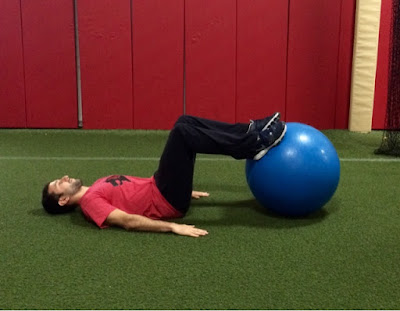There are many great tools and exercises that help with improvement of this area. There is one simple piece of equipment that many people fail to utilize for these muscle groups: a stability ball. The exercise discussed in this post using the stability ball can be used to everyone's benefit. The best part is that the body provides the resistance!
Also known as a physio ball or yoga ball, the stability ball has been around for decades. These inflated training balls come in all sizes and are frequently used for abdominal exercises like crunches, but they can be used for so much more (This DOES NOT include putting weight on your back and trying to stand and squat on the ball!). A more productive use of the ball is to get the posterior chain fired up using some Stability Ball Glute Bridges. Let's break down this movement by isolating the move from the stabilty ball.
The glute bridge is a fundamental ground-based movement. It is known by many names: hip thrust, hip bridge, or even hip bump or "upa" for BJJ and MMA practitioners. This move activates the glutes and hamstrings by extending the hips. This is completed by putting force into the ground using the legs and feet, and keeping the rest of the body stable. Does this sound familiar? That's because the glute bridge is essential in providing the base for the big exercises such as the squat and deadlift. Here's how to do the glute bridge without the stability ball.
Glute Bridge (No Ball)
Start by laying on the floor, arms out flat at the sides against the ground. Once in a comfortable position, bend the knees until the feet are flat on the ground close to the glutes, a position most know as a sit-up position.
From here, contract the abdominal and torso muscles (which most people like to call, "the core"), press the heels into the ground to elevate the hips and extend them away until they are in line with the knees and shoulders, squeezing the glutes from the initiation of the repetition.
There's no need to hyperextend the hips and put unnecessary pressure on the lower back, so stop when the basic glute bridge position is achieved. Many can master the move fairly quickly, and move on to do advanced versions of it. Eccentric-count repetitions of it (meaning slowly lowering the hips to the ground for seconds at a time), isometric holds at the top of the movement for seconds at a time, or single leg versions of it with one leg elevated all increase difficulty. Work the glute bridge until 3-4 sets of 8-12 repetitions isn't a challenge any more ,and then try the advanced versions of it. Another way to increase difficulty is by adding an unstable surface. This is where the stability ball comes in.
By adding the ball, the same benefits from doing the glute bridge are obtained, but it now incorporates the stabilizer and torso muscles of the body to cause greater activation and assistance in the movement.
By adding the ball, the same benefits from doing the glute bridge are obtained, but it now incorporates the stabilizer and torso muscles of the body to cause greater activation and assistance in the movement.
Stabilty Ball Glute Bridge
Find an average-sized stability ball and place it on the ground in front of the feet. Adjust the body until it's close enough to place the feet on the ball keeping the hips flexed at about 90 degrees. Make sure the knees are also at that angle, while also getting set up similar to the start of the glute bridge (laying down with the arms at the sides).
Now that a stable start has been reached, begin by pushing the feet into the ball, raising the hips so that they are in line with knees and shoulders, squeezing the glutes at the top of the movement, and keeping the abdominal and torso muscles contracted. This uses the stabilty ball, adding a three dimensional element to the movement, so stabilization will be required. Work on staying steady throughout the movement, balancing the body, and avoiding unnecessary movements. Do not get discouraged if the feet disengage from the ball. Practice makes perfect.
Once proficiency in the movement is attained, increase sets and repetitions (work up to 3-4 sets of 8-12 reps) or try the advanced variations of the basic glute bridge (eccentric, isometric, or single leg bridge) on the stabilty ball. Most coaches and trainers program it in as an assistance or accessory exercise during various training phases, such as the general physical preparation (GPP) or active rest/off-season training phases, because of the low stress of the exercise. Once the Stability Ball Glute Bridge is mastered, we can move on to the Stability Ball Leg Curl. This will be discussed in my next post though so until then, please feel free to ask questions, message me here, and let me know what you guys think. Meanwhile, try the Stability Ball Glute Bridge and get to training!
Alex Adragna, CSCS






No comments:
Post a Comment